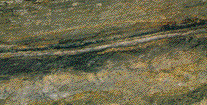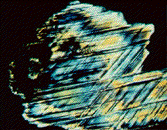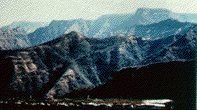Speculated Causes of the End-Cretaceous Extinction
The End-Cretaceous mass extinction has generated considerable public interest in recent years, in response to the controversial debates in the scientific community over its cause. The more prominent of these new hypoteses invoke extra-terrestrial forces, such as meteorite impacts or comet showers as the causative extinction agent. Older hypotheses cite earthly mechanisms such as volcanism or glaciation as the primary agent behind this mass extinction.

The K-T Boundary
Evidence for catastrophism at the Cretaceous-Tertiary boundary is found in a layer of sediment which was deposited at the same time that the extinction occurred. This layer contains unusually high concentrations of Iridium, found only in the
earth's mantle, and in extra-terrestrial meteors and comets. This layer has been found found in both marine and terrestrial sediments, at numerous boundary sites around the world.

Meteorite Impact
Some paleontologists believe that the widespread distribution of this Iridium layer could have only been caused by meteorite impact. Further, these researchers cite the abundance of small droplets of basalt, called spherules, in the boundary layer as evidence that basalt from the earth's crust that were melted and flung into the air upon impact. The presence of shocked quartz - tiny grains of quartz that show features diagnostic of the high pressure of impact - found in the boundary layer provides additional evidence of an extra- terrestrial impact at the Cretaceous-Tertiary boundary layer. Recent research suggests that the impact site may have been in the Yucatan Peninsula of Mexico.

Volcanic Eruptions
The high concentrations of Iridium in the boundary layer has also been attributed to another source, the mantle
of the earth. It has been speculated by some scientists that the Iridium layer may be the result of a massive volcanic eruption, as evidenced by the Deccan Traps - extensive volcanic deposits laid down at the Cretaceous-Tertiary boundary - of India and Pakistan. These lava flows came about when India moved over a "hot spot" in the Indian Ocean, producing flows that exceeded one hundred thousand square kilometers in area and one hundred and fifty meters in thickness. Such flows would have produced enormous amounts of ash, altering global climatic conditions and changing ocean chemistry. Evidence that volcanism was a primary extinction agent at this boundary is also relatively strong. In addition, and the presence of spherules and shocked quartz worldwide in the boundary layer may also have been the result of such explosive volcanism. Thus at present, both the volcanic and meteorite impact hypotheses are both viable mechanisms for producing the Cretaceous mass extinction, although the latter is more popular.
 The Holocene Mass Extinction
The Holocene Mass Extinction
 Mass Extinctions of the Phanerozoic Menu
Mass Extinctions of the Phanerozoic Menu
 Return to the Main Menu
Return to the Main Menu